N-Polytope
Behaviors of Light and Sound after Iannis Xenakis
Chris Salter, Sofian Audry, Marije Baalman, Adam Basanta, Elio Bidinost, Thomas Spier
For example for N-Polytope, an art installation I worked on, we created units that produced sound and light, and also measured sound and light. Over the steel cable architecture 48 of these units, with each one speaker, 3 LEDs and sensors were spread out. Each of the units runs on an Atmega328 microcontroller (like Arduino). The sound is output through the PWM output, which is filtered and amplified for a small loudspeaker. The algorithm is set up as a set of three wavetable oscillators modulating each other, and with individual envelopes. There is a control mechanism to set the parameters of each of the oscillators wireless and send triggers to start the sound. The choice of when a sound is triggered is based on machine learning algorithms which take their input from the sound and light sensors that are also embedded in the units. The choice of parameters is varied over the course of the composition - in different sections of the composition different types of sound are created and linked to different types of machine learning algorithms.
 N-Polytope installation at LABoral. Image courtesy LABoral
N-Polytope installation at LABoral. Image courtesy LABoral
- distributed audio (and light) synthesis units
- audio unit is an Atmel328 outputting sound through its PWM
- the audio synthesis algorithm is wavetable oscillators with three oscillators modulating each other and with individual envelopes
- (wireless) remote control for settings of the parameters and triggering of the envelopes
- control based on machine learning algorithms that get input from light and sound sensors also distributed over the structure
 N-Polytope installation at the Nuit Blanche 2015, Paris. Image by Thomas Spier
N-Polytope installation at the Nuit Blanche 2015, Paris. Image by Thomas Spier
"The ‘learning’ network studies the rhythmic and temporal patterns produced by the light and sound and helps in generating a totalizing, visceral composition that self organizes in time. LED’s and tiny speakers are suspended through the space on a single ruled surface, creating a walk-through performance environment which continually swings between order and disorder, akin to Xenakis’s original fascination with the behaviors of natural systems. Creating bursts of light as well as evolving patterns, the behavior of the LED’s suggest cosmological events, like the explosion of stars and supernovas. While the LED’s create a changing space of bursting points, colored lasers that bounce off the surface of fixed and changing mirrors generate fleeting architectures of lines and shapes that that appear, flicker and disappear before the visitors’ eyes. Counter-pointing the intense visual scenography, multi-channel audio from the small speakers as well as the larger environment fills the space, shifting between sparse natural and dense electronic textures – noisy bursts, clangerous, gamelan-like lines and percussive explosions of sound. Across the architectural structure, the network of tiny speakers produce the behaviors of mass sonic structures made up of many small elements (sonic grains) creating swarms of tiny sounds that resemble a field of cicadas or masses of insects."
Sources:
Photos, videos, sound excerpts and cited texts (c) by the artists
